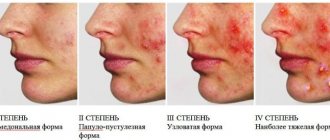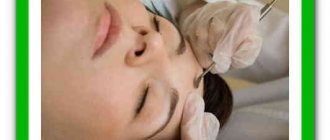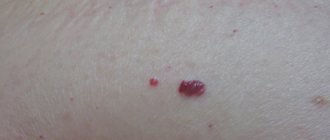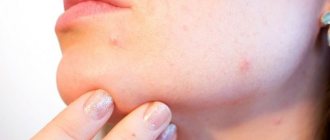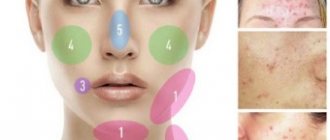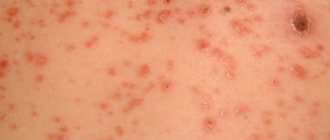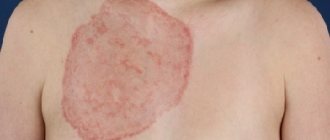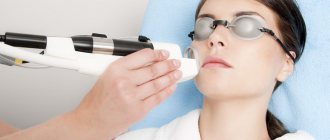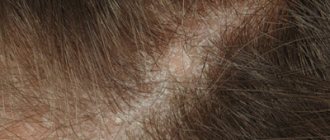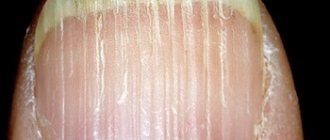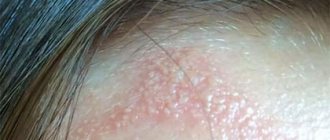Electrocoagulation
Milia on the face - how to get rid of it using electrocoagulation. It works in such a way that it acts with electric current on each milium pointwise. After removing the milia in this way, a crust forms in its place. You cannot remove it yourself so as not to leave a scar.
Carrying out electrocoagulation of milia
This method is suitable for milia of any size. The duration of the cosmetic procedure is up to half an hour. In especially rare and advanced cases, you need to repeat the procedure after 30 days.
The electrocoagulation procedure is carried out exclusively in a beauty salon. The skin is pre-cleaned before the procedure. Then they apply electric current to the affected areas. Impact on one milium from 5 s to 60 s.
After removing milia using electrocoagulation, a crust forms at the site of each whitehead, which separates on its own after 7-8 days, leaving no marks on the skin of the face.
The undoubted advantages of electrocoagulation are that the effect is made directly on the problem area, the skin that is located nearby is not damaged. This procedure makes it possible to remove even the deepest and oldest milia.
After removing milia, you need to treat the skin with lotion until the crust peels off. When using this procedure, local anesthesia is administered.
How to remove milia at home
If the patient chooses home treatment, he should be aware that there is a possibility of side effects. The risk of purulent infection of the tissues surrounding milia increases. Doctors do not guarantee 100% removal of formations if a person chooses home treatment. Some milia may remain under the skin, causing the condition to recur.
There are several methods for removing oily acne at home:
Baking soda. You must first make a soap solution, which can be obtained from children's bath foams. Such products have an almost neutral pH, so they do not dry or damage the skin. Baking soda is added there. The resulting mixture is rubbed into the places where the acne is located. After a few minutes it is washed off
It is important to know that irritation may occur after application of the product. Pumpkin with sour cream
The pumpkin should be grated on a fine grater to form a paste. It is mixed with a small amount of sour cream so that the mixture remains thick. The resulting product is applied to the skin, then washed off with water. Most often, skin irritation does not appear. Honey with yeast. You need to take fresh yeast and mix with honey. Add citric acid on top and mix thoroughly. After this, add 10 drops of hydrogen peroxide. The resulting mixture is infused for several hours. After this, apply to the face, after 5 minutes rinse with running warm water. Paraffin. Before using the product, you must cleanse your skin with tonic or lotion. Melt the paraffin mask until it becomes warm, but not hot. The resulting consistency is applied to the milia area; as soon as the mask has cooled, it is removed. Calendula. This plant causes a disinfecting effect. It is poured with a glass of hot water. Leave for 40-50 minutes until completely cooled. A cotton swab is soaked in the liquid and wiped over the face. After 30 minutes, you need to wash it off with running warm water. The same method is possible for chamomile, but it is necessary to alternate different herbs with each other. Kalina. It is necessary to take fresh berries, they should not be frozen. The juice is squeezed out of them and mixed with flour. You should get a paste that can be applied to your face, but it should not spread. The mask is kept on the face for 30 minutes, after which it is washed off with running warm water. Sea salt. You need to take 2 tablespoons of the product and add a small amount of cool water. You can't wait for the mixture to melt. The product is applied to the face as a peeling, rubbing the skin a little. After this, you need to wash off the solution. To avoid irritation, you can dissolve the salt in olive oil instead of water.
If the patient is allergic to any herbal remedies, it is recommended not to use calendula, chamomile, or berries, as a cross-reaction may develop. It manifests itself in rash, itching, inflammation, redness. If such a reaction occurs, you need to take an antihistamine and consult your doctor.
Removing it yourself at home
If there are few formations and they do not cause discomfort, it is not necessary to seek help from a specialist. If there is a problem on the face, treatment can also be carried out at home. Although everything must be done very carefully, since infection can easily be introduced into the wound. Therefore, if you are not sure, it is better not to take risks, but to consult a doctor.
Do-it-yourself cleaning
If certain circumstances do not allow you to visit a cosmetologist, then during the procedure at home you need to follow a number of rules:
First of all, you should wash your hands with soap and lubricate them with an antiseptic composition. Be sure to cleanse your face of dirt and makeup.- Prepare a cosmetic needle, soda, boiled water, alcohol and hydrogen peroxide. You will also need Xeroform and clean cotton pads.
- Before you start squeezing out formations, the skin must first be steamed. Take a pan, pour boiled soda solution into it, for the preparation of which you need to dilute two teaspoons of soda in one liter of water, heat it and hold your face over the pan, covering your head with a towel, for 10 minutes.
- When your skin is soft enough, blot it with a paper towel.
- For the procedure you will need a sterile needle. If you can’t get one, you can use a regular one, which must first be boiled for 20 minutes and then wiped with alcohol.
- Now you need to carefully pierce the millet with a needle, and this should be done in such a way that the needle enters the growth at a right angle.
- When you push through the formation, contents will begin to flow out of it. You need to press on the millet until the ichor appears. This will be a clue that the nodule shell has come out.
- After the procedure, the wound is treated with hydrogen peroxide, and then covered with Xeroform.
After you remove the formation, it is necessary to ensure proper care of the treated areas of the skin. All wounds should be lubricated with an antiseptic and sprinkled with an antibacterial composition. This will help prevent infection and skin damage.
Folk remedies
When trying to get rid of millet grass at home, you can turn to traditional medicine. With the help of folk remedies, you can quickly get rid of millet grasses without putting mechanical pressure on them .
- A well-proven remedy is compresses based on freshly squeezed viburnum juice. Just take a bandage, soak it in viburnum juice, then place it on your skin and leave for 15 minutes.
- A gruel made from crushed golden mustache helps well in the fight against millet grass. It is recommended to make compresses based on this plant at night, additionally fixing them to the face with gauze.
- An effective remedy is a compress based on milk and wheat flour. It is very important that the mass is thick and cannot flow off the skin. You need to keep the compresses for 40 minutes.
- A mask based on sour cream (15 g) and pumpkin puree (20 g) can help cleanse the skin. After mixing the ingredients, the resulting composition is applied to the skin and left for 15 minutes.
- You can also use a product based on hydrogen peroxide and bodyagi powder (15 g). A mask is prepared from these ingredients, which is washed off after 15 minutes.
- A mixture based on egg white and honey has a cleansing effect. This mixture is smeared on the millet, and after 15 minutes it is removed.
- To cleanse your facial skin of millet, you can use a composition made from crushed garlic and sunflower oil (30 ml). This composition should be lubricated three times a day on problem areas of the skin.
Expert opinion
Michelle Ellern
practicing cosmetologist-dermatologist
I consider laser and radio wave treatment to be the most effective and safe methods for removing multiple milia. But the first method is not suitable for everyone, because not every type of laser can be used on dark skin. I recommend radio wave treatment to such patients.
Theda Contis
plastic surgeon
If the milium is located singly, then it is easier and faster to get rid of it using the method of mechanical removal or curettage - scraping out the cavity of the opened cyst using a curette (slight adjustment of the spoon)
We recommend watching an interesting video that shows how to get rid of milia using traditional methods:
Of course, milia on the face are not a threat to a person’s life, but they spoil the appearance and add self-doubt. That is why you should think about removing them. Moreover, there is more than one method.
Forms of milia
According to the method of occurrence, there are 2 forms of millet grass:
- Primary are milia that suddenly appear and also go away unexpectedly and on their own. Such rashes are safe; they appear locally or in the form of focal rashes. Primary milia are diagnosed in newborns as a process of adaptation to new living conditions and imperfect regenerative and metabolic processes.
- Secondary - milia appear on damaged skin due to the development of an inflammatory process. Untimely treatment or improper self-removal of secondary forms of grasses is fraught with the formation of scars and cicatrices. The formation of secondary forms of millet grass can be diagnosed after frequent chemical peeling, long-term external use of steroid medications, and the use of low-quality cosmetics.
The following people are at risk of developing milia on the face: patients with chronic dermatological diseases, patients with 2nd and 3rd degree facial burns, clients who abuse frequent cosmetic procedures with chemical components.
If cysts are detected, it is important not to self-medicate and it is strictly forbidden to remove the formations yourself without visiting a dermatologist. Because you can completely and effectively get rid of white spots on your face only by correctly and timely determining the shape of the milia.
Primary sources of problems
Before going to the beauty salon, potential patients are asked to understand the reasons for the prosyanka. There are many factors for its occurrence, so several aspects often provoke a surge in a peculiar release of sebum.
Moreover, it is not even so important how high quality the product turned out to be. It’s just that when the sebaceous glands are clogged with a thick layer of powder, foundation or any other tinting agent, the skin pores stop working normally
Also, the reasons for unsightly covering the face with small wen are:
- incorrect functioning of some internal organs;
- improper diet;
- excessive use of thermal procedures.
The first point of the program affects malfunctions not only of the gastrointestinal tract, but also of the pancreas and liver. Either one body or all at once may cease to perform its duties. In this situation, trying to excise the tubercles with a laser will be a futile exercise. You will have to start treatment from the inside to remove the barrier to glowing, beautiful skin.
Abuse of junk food becomes a direct path to obesity. The deposition of excess sebum in milia works on an identical principle. When the daily menu contains an abundance of excessively salty, sweet, fried or smoked food, this will quickly affect a person’s appearance.
Tanning is no less dangerous. Moreover, we are talking not only about visiting a solarium, but also about a long stay on the beach during the hottest hours.
In adolescents and middle-aged women, hormonal changes become the primary source of difficulties. An equally common cause is toxic poisoning of the body from within, which occurs with prolonged methodical accumulation of toxins. Bad habits such as drinking alcoholic beverages and smoking also add to the risk of being affected by fat “grains”. People who suffer from increased dryness of the skin of the face should be especially careful. But the most important pillar for the development of lesions is insufficient skin hygiene. This applies to both the inability to choose normal skincare products and the habit of not washing off makeup before bed.
Milia: a small educational program
Milia look like small formations rising above the surface of the skin, which are characterized by a white color and clear boundaries. They are easily identified visually, especially noticeable on dark skin. If there are many such formations and they are located close to each other, then the skin in these places becomes rough and grooves appear on it.
Sometimes such a cosmetic defect disappears on its own after a few weeks or months, but often it is corrected by cosmetologists.
What is millet
Prosyanka is the second name for milia, “folk”, more understandable to every person. They are small “grains” (hence the popular name) with yellowish contents. Their size does not exceed 3 mm, but more often ranges from 0.5-2 mm. They do not pose any threat to human health or life; doctors classify them as cosmetic defects.
Most often, millet is localized on the eyelids, temples, nose and area around the eyes. They can be single or form large groups.
Structure of milia on the face
The structure of milimums is fundamentally different from that inherent in comedones - it is a cyst capsule, the bottom and walls of which are lined with epithelial cells. Sometimes the secretion of the sebaceous glands is mixed into this mass, but in very small quantities - the millet does not have the effect of squeezing out and removing the contents. Milia on the face are located separately from the sebaceous, sweat glands and hair follicles.
It is extremely rare that when milia are pierced, a drop of a whitish, thick and viscous substance comes out. Since they are located in the superficial layer of the dermis, they can only be removed by specific cosmetic procedures.
Acne characteristics
The description of the “pimples” in question boils down to the following:
- formations of small sizes;
- extremely rarely become inflamed;
- protrude above the surface of the skin.
Milia remain in their original size for a long time; they cannot be squeezed out or disguised with foundation - the protruding tubercle will still be noticeable to others.
Why did they appear on the face of a newborn?
Milia often appear on the face of a newborn, and the reason for this is the transitional period of adaptation of the baby’s body to the environment against the background of imperfections in the immune system and metabolism. The baby's millet disappears on its own; no therapeutic measures are taken.
Most often, milia in newborns are localized on the forehead, in the area of the bridge of the nose and “wings” of the nose, around the mouth. They are almost never isolated.
Reasons for the appearance of milia on the face in adults, on the back
Reasons for the formation of milia on the face in adults:
- hormonal imbalance - occurs with diseases of the endocrine system, during menopause, adolescence, with pathologies of the adrenal glands or thyroid gland;
- problems in metabolic processes - they proceed too slowly;
- lack of vitamin A - can occur against the background of progressive diseases of the digestive system, with improper/poor nutrition;
- hereditary predisposition.
In fact, the listed conditions cannot be called the true causes of the appearance of millet in an adult, because they have not been fully elucidated. But these are provoking factors, you can add to them excessive tanning, constant exposure to direct rays of the sun (they serve as a “push” for the formation of milia on the back), and the use of low-quality or inappropriate cosmetics for the type of dermis in facial skin care.
Why can they be found on the labia?
Milia form on the labia only due to hormonal imbalance. The risk group among women is pregnant women in menopause. Milia in the intimate area can be single or form in groups. They are not dangerous, rarely open, and therefore the risk of infection is almost zero.
Symptoms of presence on the eyelid, under the eyes, on the forehead, lips
Diagnosis of milia on the eyelid, under the eyes, on the forehead and lips begins with an examination of the rash by a dermatologist or cosmetologist; the main symptoms of the formations are:
- the size of the “pimple” is small;
- there is no redness, swelling or other signs of inflammation around it;
- palpation reveals a dense structure of the millet.
Milia are painless, slightly raised above the general surface of the skin, and do not lend themselves to mechanical extrusion.
Since it is necessary to differentiate harmless milia from fibroma, syringoma, trichodiscoma and xanthelasma, the doctor will extract the contents of the formation and send it for histological examination to the laboratory.
Common skin diseases. 2. Comedones. Milia.
Published: June 28, 2015
Author: O.Shar
Categories: Aroma-Dermatology
Print this article
Closed comedones. Milium. How to treat closed comedones. What is milia? Causes of milia. Essential oil for closed comedones. prevention of closed comedones.
Closed comedones are clogged ducts of the sebaceous glands, in which secretions and dead epithelial cells accumulate. They do not have contact with the environment, so they are not prone to inflammation.
Upon visual inspection, they look like tubercles. Their size can reach up to 5mm. Closed comedones differ from open comedones by the absence of a pore crater and a black plug.
Most often, closed comedones form on the forehead, cheeks, chin, nose, and less often on the chest or back.
Comedones do not itch, hurt or bother you, provided you do not disturb them.
Skin covered with comedones looks lumpy and unkempt, so let's figure out how natural essential and fatty oils can help cope with this problem.
The causes of closed comedones are milia.
1.Changes in hormonal levels.
Changes in hormonal levels activate the sebaceous glands, so the first rashes begin in adolescence. During life, comedones appear:
- with irregular sex life,
- when taking oral contraceptives,
- when taking anabolic steroids,
- during pregnancy,
- during breastfeeding,
- during menopause and menopause.
2. Mistakes in skin care.
Any skin needs cleansing and exfoliation of the dead layer.
Skin care rules for comedones:
- do not use foundation,
- remove makeup daily,
- cleanse the skin with antibacterial agents,
- Use exfoliators once or twice a week to help remove dead skin cells.
3. Nervous disorders.
Any stress is reflected on the skin. If depression is accompanied by smoking, drinking alcohol and antidepressants, then all cosmetics will be in vain. It is necessary to eliminate the cause of stress and stop taking antidepressants.
4.Eating mistakes.
Proper nutrition, together with other measures, will guarantee the disappearance of comedones.
- Eliminate sweets from your diet. Sweets make the cell permeable.
- Eliminate excess fatty foods. It increases secretion production.
If you notice digestive disorders, feel pain, heaviness, nausea, flatulence and other manifestations, then you need to make a visit to a gastroenterologist. Normal digestion will provide you with clear skin.
5.Genetic (hereditary) predisposition.
Oily skin, which you inherited, requires a more attentive attitude towards yourself. Cleansing products should be selected individually and used regularly - morning, afternoon and night.
Treatment methods for closed comedones (milia).
If open comedones are simply eliminated through the pore hole, then closed comedones take a very long time to be treated.
Do not try to remove them by squeezing. This will not lead to a positive result. Above closed (internal) comedones there is a very dense layer of skin. Squeezing with fingers or other instruments will cause injury to the skin around the comedone.
Treatment should begin with softening the epidermis. Then you need to thin the top layer by removing dead horny skin particles. These measures will ensure the outflow of secretions from the sebaceous gland.
1.Softening the epidermis by steaming.
Thanks to the action of hot steam, the smallest pores open.
For greater effect, you can add essential oils of rosemary, lemon balm or lemongrass to the water. These oils have the ability to expand pores, cleanse them and even out skin texture. You can use hydrosols or decoctions of plants. This is also a very effective remedy.
Steaming methods.
Bath. Prepare a decoction of chamomile flowers, calendula, oak bark or lemon balm. Lean over a bath of hot water and cover your head with a towel. The water should not be too hot, otherwise you will burn your skin. The duration of the procedure is 8-10 minutes.
Bath. Once a week it is recommended to take a warm bath with aromatic salt or essential oil.
Bathhouse. Sauna. Thanks to the hot steam, the skin pores will easily open. Eucalyptus essential oil will help make the procedure more effective. How to use essential oil in a bath here>>>
Compress. Soak a thin terry towel in herbal infusion or water with rosemary or lemon balm essential oil. Then lie down and place a towel on your face. The duration of the procedure is 10-15 minutes.
After the steaming procedure, you need to do peeling. This will remove dead skin particles.
Buy bulk fractions for peeling, scrub>>>
2.Exfoliation. Removing dead skin cells.
Milia tend to occur in areas where the skin is thicker and thicker. Peeling will help deal with them.
Peeling classifications.
- Mechanical peeling or scrubbing is performed by lightly rubbing the problem areas of the skin with loose fractions.
- Chemical is carried out by applying organic acids to the skin. Aga-vital buy>>>
Skin peelings differ:
- depth of
penetration into the skin, - method of removing horny particles
Peeling can be superficial. Thanks to it, you can remove the very top layer of cells. For this purpose, various acids and small bulk fractions are used. Chemical acid peeling helps eliminate fine wrinkles, post-acne, acne and age spots.
Scrubbing or mechanical peeling is used to remove rough horny particles from the body and face. It is important to remember that the movements should be light, circular, without pressure. People with very thin skin should use mechanical peeling extremely carefully!
Medium depth cleansing is performed with a special apparatus. It regenerates the skin, helps eliminate shallow wrinkles, scars, freckles, post-acne and age spots, and promotes rejuvenation.
Deep cleansing - Allows you to cleanse several layers of skin down to the epidermis. It eliminates the effects of acne, scars, skin folds, deep wrinkles, and promotes rejuvenation.
Deep cleaning can only be carried out by specialist cosmetologists. Cleaning at home is very difficult and painful.
The exfoliation procedure is performed at least once a week. Both types of peeling (mechanical and acid) complement each other perfectly. The procedures can be combined. First, acid peeling is performed, and then mechanical peeling is performed to remove softened tissue.
DIY peeling>>>
Removing melium at home.
Melium removal is recommended if a closed comedone is inflamed and is white and closed on the skin. If there is no white center, and only a tubercle is visible, this formation cannot be squeezed out.
Steaming and exfoliating may not open up deep cavities. The best solution would be to visit a cosmetologist or resort to the following procedure:
- Cleanse your face with cleanser.
- Remove dead cells using the exfoliation method (described above).
- Steam your skin.
- Wash your hands thoroughly with soap and wipe them with alcohol or alcohol tincture.
- Sterilize a thin needle and all available tools. You can take a needle from a small syringe.
- Stretch the skin around the comedone and pierce the center of the formation with a needle. The injection should not be very deep. It is important to disrupt the integrity of the cyst.
- Press the skin around the puncture with your fingers while stretching it to the sides. There is no need to squeeze or extrude. This way you will not allow the infection to spread. It is very convenient to perform the removal procedure using a Uno spoon and a Vidal loop. A loop and spoon allow you to remove the core of a comedone or cleanse a pore of dirt.
- Wipe your skin with a disinfectant such as tea tree essential oil.
If you fulfill all the requirements and follow the instructions, you will be pleased with the result. Home facial cleansing is less painful than having a cosmetologist, since you can adjust the pressure.
List of essential oils for the treatment and prevention of comedones.
- Bergamot - regulates the functioning of the sebaceous glands,
- Verbena - regulates the functioning of the sebaceous glands,
- Vetiver - stimulates skin regeneration, saturates with oxygen. Eliminates inflammation and irritation.
- Cloves - regulates the functioning of the sebaceous glands.
- Geranium - regulates the functioning of the sebaceous glands. Stops bleeding in the wound (after removing the comedones).
- Grapefruit - regulates the functioning of the sebaceous glands, eliminates oily skin. Stimulates skin renewal.
- Oregano - regulates the functioning of the sebaceous glands, eliminates oily skin.
- Ginger - improves micro-circulation in the lower layers of the skin. Promotes regeneration, tones, nourishes and softens the skin. Regulates the functioning of the sebaceous glands. Eliminates inflammation.
- Kayaput - stimulates skin regeneration. Relieves inflammation. Regulates the functioning of the sebaceous glands.
- Atlas cedar - regulates the functioning of the sebaceous glands, eliminates oiliness.
- Virginia cedar - regulates the functioning of the sebaceous glands.
- Cypress - regulates the functioning of the sebaceous glands. Stops blood in the wound (after removing the comedones). Relieves skin inflammation.
- Lavender - stimulates the growth of new cells. Increases skin elasticity. Relieves irritation and inflammation.
- Frankincense - regulates the functioning of the sebaceous glands.
- Lime - tones, refreshes the skin, promotes healing.
- Lemon - regulates the functioning of the sebaceous glands, eliminates oiliness. Tones and refreshes the skin. Stops bleeding in the wound (after removal of the comedones)
- Lemongrass - expands pores, helps cleanse and remove secretions.
- Mandarin - increases resistance to inflammatory processes. Soothes irritation.
- Melissa - regulates the functioning of the sebaceous glands, eliminates oiliness. Tones the skin, opens pores and promotes secretion removal.
- Myrrh - eliminates inflammation.
- Myrtle - regulates sebum production. Relieves skin inflammation.
- Juniper - stimulates skin cell renewal. Regulates the functioning of the sebaceous glands, eliminates oiliness.
- Carrots from seeds - stimulates the growth of new cells. Nourishes, moisturizes and tones the skin.
- Clary sage - regulates the functioning of the sebaceous glands. Promotes skin regeneration.
- Peppermint - tones the skin and refreshes it.
- Palmarosa - tones the skin, promotes regeneration.
- Patchouli - regulates sebum production.
- Petitgrain - nourishes the skin. Relieves inflammation.
- Rose - tones the skin, improves microcirculation. Stimulates the growth of new cells. Relieves inflammatory processes.
- Rosemary - stimulates the growth of new cells. Improves blood circulation, opens pores. Regulates the functioning of the sebaceous glands, eliminates oiliness.
- Rosewood stimulates the growth of new cells. Nourishes the skin, relieves inflammation.
- Chamomile - stimulates the growth of new cells. Relieves inflammation of the scalp. Eliminates itching.
- Roman Chamomile - stimulates the growth of new cells. Relieves inflammation of the scalp. Eliminates itching.
- Sandalwood - stimulates blood circulation in the skin, promotes the growth of new cells, relieves inflammation.
- Pine - nourishes, improves blood circulation. Eliminates itchy skin.
- Yarrow - stimulates the growth of new cells, relieves irritation and inflammation.
- Thyme - regulates the functioning of the sebaceous glands, eliminates oiliness.
- Tea tree - relieves inflammation
- Eucalyptus - tones and refreshes the skin. Opens pores.
Masks with cosmetic clay.
Using clay, you can remove impurities from the skin, eliminate inflammation and significantly reduce pores. Clay varies in quality and properties. Therefore, first of all, you need to decide on the choice of clay, taking into account the characteristics of your skin. Buy clay>>>
The procedure is very simple:
Clay powder is diluted with water or broth until a homogeneous thick mass is obtained, reminiscent of sour cream. The clay is applied to a clean face with light circular movements. Then it is left until completely dry (15 minutes). After drying, the clay mask is washed off with warm running water. For the effectiveness of the procedure, it is recommended to peel with fruit acids. These can be fresh berries or fruits, for example, lemon, strawberries, sea buckthorn, raspberries, red currants, etc. The main thing is that they do not stain the skin, as blueberries do.
Recipe for an aromatic mixture against comedones:
• Violet absolute – 3 drops • Lemongrass essential oil – 3 drops • Lavender essential oil – 1 drop • Clary sage essential oil – 1 drop • Basil essential oil – 3 drops • Basic fatty oil, such as jojoba, argan, wheat germ – 50 ml
Store the mixture in a cool place, in a dark bottle, tightly closed. Use as a nourishing agent at night after cleansing procedures. Remove excess with a napkin.
Aromatologist Sharova Olga... with love
Next post: Common skin diseases. 1. Acne. ->
Interesting on the topic:
The structure of human skin. Epidermis. Hypodermis. Structure and functions of the skin...
Essential oils for skin diseases.
Traumatic skin lesions: burns, frostbite, wounds, trophic ulcers….
Common skin diseases. 1. Acne.
Procedures and operations
The most common procedure for removing millet grass is the mechanical method. First, the skin is treated with an antiseptic. Then the specialist uses a sterile needle, opens the membrane, lifts the cyst and pushes it out. For this purpose, a special curette that resembles a spoon is also used. This tool makes it possible to completely scrape out the milia, and then the remnants of its contents will not turn into a cyst again after some time. In one procedure, a certain number of formations are removed – no more than 10.
Milia under the eyes are removed using radio waves, and diamond cleaning is also used. A more aggressive method is burning (laser removal, electrocoagulation), which acts on the formations in a targeted manner.
Sometimes milia disappear on their own after a few months as the skin renews itself.
It is also important to ensure proper skin care and use products that will help normalize the oiliness of the epidermis.
Prevention
Since milia, like warts, do not pose a health threat, they do not need to be removed at all. But if they create a significant cosmetic defect, it is better to contact a specialized clinic or beauty salon.
Prevention of the appearance of milia is as follows:
- It is necessary to select suitable skin care cosmetics and regularly carry out cleansing procedures using scrubs and peels. Cosmetics should be chosen taking into account age, skin type and individual characteristics.
- To reduce the risk of millet formation, you need to reconsider your diet. You should limit your consumption of fatty, smoked, sweet and fried foods.
- If you have gastrointestinal diseases, you should consult a doctor to undergo a course of therapy, which will reduce the risk of milia formation.
- In summer, for the purpose of prevention, it is necessary to use creams with ultraviolet protection.
Treatment options
A doctor must perform the operation to remove milia.
Treatment for milia involves removing them. This procedure is quite simple, however, it is strictly not recommended to carry it out at home. The fact is that at home it is almost impossible to ensure the required degree of sterility, so there is a high risk of infection of the wound left after removal of the milium.
Whiteheads should be removed by either a dermatologist or a cosmetologist under appropriate conditions. The operation is extremely simple: a sterile needle is used to puncture the skin above the milia, after which its contents are carefully removed.
After the procedure for mechanical removal of whiteheads, small wounds remain on the skin, so you will need to treat the skin with antiseptic solutions for a few more days.
As a rule, they try not to remove more than a dozen milia at a time, so as not to severely injure the skin and not disrupt the activity of the sebaceous glands.
In addition to mechanical removal of whiteheads, other treatment methods are sometimes used.
- Electrocoagulation. When using this technique, high frequency current is used to remove milia. After the procedure, crusts remain at the site of the acne, which disappear after 1-2 days.
- Removal of milia with laser. The principle of treatment using this method is similar to that described above, only a laser is used instead of current. The procedure is completely painless and allows you to effectively remove whiteheads.
- Curettage. This is another type of mechanical removal of whiteheads, actinic keratosis and seborrheic keratosis. In this case, after opening the cyst wall, the contents of the milium are removed using a special instrument - a curette, which looks like a spoon. This method of treating milia is used quite rarely, since after it noticeable scars can form on the skin.
After treating whiteheads with laser or electrocoagulation, the patient will need to treat the skin with antiseptic solutions for several days to eliminate the risk of infection.
How to remove milia?
To get rid of a white pimple that appears in a visible place, you need to visit a cosmetologist. Milia are eruptions that cannot be squeezed out, so external exposure to them must be done with caution. Main methods:
- Using a disinfected needle. With its help, the integrity of the top of the pimple is violated. Then it is allowed to squeeze out the liquid contained inside. You should not try to remove a subcutaneous formation without auxiliary tools. This will only provoke the appearance of a new rash, which usually occurs under external influence when the skin is deformed. If you are wondering whether it is possible to squeeze milia under the eyes and on the eyelid, you must remember that such manipulations are not recommended for these areas. Provided that the instrument (needle) is carefully treated, white pimple removal is possible at home, but it is better to consult a specialist.
- Exposure to electrocoagulation and laser. If you are deciding how to remove whiteheads, you need to know that these formations are of a specific nature, so in this case, laser therapy and a carefully processed needle are approximately equal in level of effectiveness.
Laser method for milia removal
If the root cause is not removed, a large white pimple or a whole group of rashes will periodically appear on the skin. This means that you will have to repeat the procedure to remove the formations from time to time. If you are wondering how to get rid of white pimples forever, you need to know that you first need to provide quality skin care. Keratolytic removes milia. This is a remedy that promotes the intensity of epithelial exfoliation.
When a white, hard pimple appears on the skin, the most common keratolytics are used: hydroxy acid, salicylic acid. Creams based on similar substances are popular. Treatment for acne should be prescribed by a specialist, because any medications have contraindications, and if used incorrectly, the risk of side effects increases. It is impossible to use keratolytics for a long period, as these substances can cause the development of hypopigmentation, skin atrophy, and dermatitis.
Salicylic acid works great for milia
If whiteheads appear on your face, how can you get rid of them using the safest method for your skin? For this purpose, different types of keratolytics are used:
- alkaline;
- acidic.
With their help, you can remove formations of any size. If a huge white pimple appears, it is removed using similar means. Keratolytics help bring milia to the surface. As a result, the eel, along with its contents, bursts during treatment of the skin. There are different products with a keratolytic effect. These are not only creams, but also gels and liquids. The cost of such substances depends on the volume of the bottle and can vary from 500 to 3000 rubles.
It is possible to remove whiteheads with the help of keratolytics
Apart from eliminating the causes of white pimples and using keratolytics to facilitate the removal of lesions, other therapeutic measures have not yet been developed. A dermatologist may prescribe medications from the retinoid group, for example, tretinoin cream. Such products contain pure retinoic acid, which is the most effective form of skin-beneficial vitamin A. For this reason, such preparations are often prescribed for various skin diseases.
How is diagnosis carried out?
A cosmetologist will help you get rid of problematic milia on your face, but first it is recommended to consult a dermatologist. The doctor will examine the affected area and make a diagnosis based on the clinical picture. Standard removal is carried out as follows: the doctor cleans the skin and makes an incision in the area of the stratum corneum of the tumor. The pus or solid core is then removed (depending on the type of milia). To exclude a malignant process, you need to send the material for histology. The study will reveal what contents are in the horny mass. Depending on the characteristics of the skin, the extracted core can be dense or loose.
Millet requires differential diagnosis, during which it is distinguished from a retention cyst of the sebaceous gland. This disease develops in people suffering from seborrhea. Doctors have not developed preventive measures that could prevent the appearance of milia. To avoid acne and other skin defects, you need to eat right, eliminating spicy, salty, pickled, and peppered foods from your diet.
It is important to cleanse your pores in a timely manner. Cosmetics should be selected based on the needs of your skin
You should not buy products of questionable quality. Acne, in which ulcers form on the face, is often associated with stress and lack of sleep. Thus, conflict situations must be avoided. It is necessary to rest in a timely manner. Prevention of infectious and inflammatory diseases should be observed.
Treatment
So how to remove milia on the face? Removal should only take place in a dermatology clinic or a cosmetologist. You cannot get rid of them at home, much less squeeze them out, because in this case there is a risk of skin damage, as well as infection in the wound.
Recent Posts Is it possible to give a mirror as a gift: how to protect yourself from bad omens It became known about the influence of cell phone towers on human health Is it possible to eat bananas bought in Russia?
Answering the question of how to remove milia on the face, it is worth noting that thanks to modern technologies, there are several methods of removal. Which one to choose is up to you and your doctor to decide, because the treatment method primarily depends on the location of the rash, skin type and the size of the acne itself.
Basic removal methods:
- mechanical;
- hardware.
The mechanical method of removing milia involves going to a beauty salon. After disinfecting the skin, the cosmetologist punctures it with a thin needle, which then removes the contents of the nodule. The wound is small, so there are no scars left after the procedure.
Hardware removal includes the following types of getting rid of whiteheads:
- Electrocoagulation. During the procedure, high frequency current is used, which dries out the rash. In their place, crusts appear, after two days they fall off and the face becomes clear. There are no scars left and the surrounding tissue is not damaged, which is the main advantage of the method.
- Laser removal. When milia appear on the face, treatment can be done with laser. The procedure is similar to electrocoagulation, only the rash is burned with a carbon dioxide laser. The method is used only on large clusters of acne. The advantages are that the procedure is painless, quickly carried out, the result comes instantly and there are no side effects.
- Cryotherapy. The method is intended for removing milia on the eyelids. They are frozen, because the skin on the eyelids is thin and delicate, and even a slight impact can lead to redness and swelling, so they use the cryotherapy method.
Reasons and mechanism of formation
During intensive work at the monitor, the speed of blinking movements of the eyelids is reduced several times. So, if normally it is 17-18 blinks, then when working at a computer it is reduced to 3-4.
As a result, the tear film is destroyed and the eye dries out. Under normal conditions, constant blinking movements moisten the eye every time and contribute to the uniform distribution of tears over the surface of the eyeball.
A person feels the drying of the tear film in the form of a burning sensation, a feeling of a foreign body or sand in the eyes, itching or tingling.
The second reason for computer vision syndrome lies in the fact that during intense work the extraocular muscles are also in a state of static tension.
As everyone well knows, muscles act as a kind of pump, which actively participates in the blood circulation process.
However, as a result of static work, the speed of blood flow inside the eye slows down, and the eye begins to suffer from hypoxia - oxygen starvation.
In order to somehow activate blood flow, compensatory mechanisms are launched, and the blood vessels of the eye dilate. As a result, we observe redness of the eyes.
What to do if your eyes hurt from working at the computer? Methods for restoring vision with myopia What to do with eye pain due to a cold
And the human eye is adapted to perceive objects in reflected light
As a result, the visual analyzer experiences overload, which people often call eye fatigue. The situation gets even worse if a person, while working, needs to constantly look from the monitor to a text document printed on paper.
Proper organization of the workplace is very important.
This refers to poor lighting in the workroom, a discrepancy between the size of the table and chair and a person’s height, poor technical parameters of the monitor, incorrect placement of light sources on the table, when glare appears on the monitor every now and then.
Features of milia treatment
Rashes are often eliminated using cosmetic preparations with an exfoliating effect. For this purpose, creams and ointments that contain urea and salicylic acid can be used. When they are used, miliary cysts spontaneously emerge on the surface of the skin.
However, often such therapy does not bring a positive result and it is necessary to resort to more radical measures. It is possible to remove the white wen in the eye area in the office of a specialist who, after an examination, will select the most effective treatment.
Mechanical removal
To remove rashes in the eye area, a treatment method such as a mechanical method can be used. The essence of the technique lies in the fact that the skin is initially pre-cleaned. After this, the epidermis is disinfected, and then the milia are removed. Using a sterile needle, the skin is punctured under the desired node. As a result, it is possible to slightly undermine the epidermis and remove the body of the acne formation.
This procedure is considered quite painful and causes severe discomfort to the patient. In addition, a wound may form in the area where the needle is inserted under the skin, which requires careful care. Proper wound care can speed up the complete healing of the epidermis.
Electrocoagulation
Electrocoagulation
One of the effective ways to combat rashes on the dermis is electrocoagulation. During the procedure, damaged areas of the dermis are exposed to high-frequency electric current. After coagulation, a crust forms on the surface of the epidermis, which cannot be removed independently. After a while, it disappears and leaves no trace behind.
The duration of the procedure depends on the area being treated and usually does not exceed 15-30 minutes. If the procedure is carried out correctly, there is no need for re-therapy. In some cases, a person develops too many rashes on his face, so a month later, repeated electrocoagulation is required.
Compared to treating formations mechanically, electrocoagulation has many advantages. This procedure allows for a limited effect on individual rashes and does not harm nearby tissues. In addition, electrocoagulation makes it possible to remove milia, which are localized deep in the dermis.
Laser removal
Laser
Laser coagulation is considered one of the most effective methods for removing large clusters of acne. With the help of the procedure, it is possible to quickly remove formations and avoid trauma to nearby tissues. After the procedure, the risk of scarring is minimal, and the recovery process is painless and quick.
It is not allowed to remove milia using a laser in the following cases:
- oncological tumors;
- herpes in the acute stage;
- autoimmune pathologies;
- pregnancy;
- lactation period;
- rise in body temperature;
- hypertension.
Immediately after completion of the procedure, you are allowed to go home. Minor swelling and redness of the treated areas may remain on the patient's skin for two weeks.
Cryotherapy
Cryotherapy
During cryotherapy, controlled destruction of milia is observed. Problem areas of the skin are exposed to low temperatures, and liquid nitrogen is used to remove milia.
During this treatment, acne formations are removed due to the formation of ice in the affected cell. The lower the temperature of liquid nitrogen, the faster the process of cell destruction occurs. Cryotherapy is performed in cycles of freezing, followed by thawing of the milia.
The advantage of cryotherapy with liquid nitrogen is the low risk of infection of damaged tissues. The treatment is carried out without the use of local anesthesia, and there is no scarring after it. In addition, no special wound care is required after cryotherapy.
However, minor bleeding may occur with this treatment method. In addition, blisters, scars and increased hyperpigmentation may form in the area of the removed acne.
What is piglet?
Milium (also known as piglet in everyday life) is a white lump, similar to a pimple, of small diameter (1-4 mm). It is mainly localized on the face, but other areas of location are possible. Piglet rash occurs in both men and women, regardless of age. Milia on the eyelid can occur in single or multiple quantities. This is a type of acne that causes external discomfort, but does not harm the body. The structure of the piglet is dense, non-walking. They occur in the epidermis without affecting the dermis. With such manifestations, the skin of the face does not look healthy. They are difficult to hide with decorative cosmetics. Getting rid of milia that appears on the eye on your own is just as difficult and sometimes dangerous. If their number increases and the skin turns red, you should immediately contact a dermatologist who will prescribe the correct treatment.
General clinical picture
From the point of view of specialists in the field of dermatology, millet is a retention or follicular cyst. Such a cyst is formed due to blockage of skin pores by horny masses. In medicine, there are two main types of whiteheads on the face: primary and secondary. The primary forms are formed spontaneously, and the secondary ones, which are called Balser's pseudomilium, most often appear in scars at sites of damage to the skin due to inflammation or mechanical trauma.
https://youtube.com/watch?v=uvxJpaN72WQ
The main unpleasant feature of milia is that they very rarely disappear on their own, so they spoil the appearance of the face for several years.
Externally, these neoplasms appear as a white dense or yellowish nodule that protrudes above the surface of the skin. The walls of such neoplasms consist of simple epidermis, while all its layers are preserved. The contents of dense nodules are dense horny masses, where a small amount of fat impurities is also present. The size of one milia ranges from 0.5 to 3 mm in diameter. The patches are mainly localized on the skin of the face, chin, and eyes, but they can also appear on other parts of the body, including even the genitals.
Whiteheads can exist unchanged for several years, without causing any physical discomfort to a person, except that they are a cosmetic defect. In some cases, the grasses open up on their own and disappear. If a secondary infection gets into the neoplasm, inflammation and suppuration may develop.
https://youtube.com/watch?v=iQluH5dyy7c
What not to do
Some parents may be overzealous in their efforts to cleanse their baby's skin of various bumps and rashes. The measures they take may be completely unnecessary. Such manipulations include:
use of products containing various types of alcohols. they can damage the baby's skin, causing itching, dryness, peeling and even chemical burns. Such preparations include not only lotions for cleansing the skin of adults, but also alcohol solutions of brilliant green, fucorcin and iodine;- applying moisturizing creams, oils or other products that are highly oily to the baby’s skin. These manipulations will lead to further clogging of the pores and accelerate the formation of not only harmless milia, but also other inflammatory skin processes;
- attempts to squeeze out milia or pierce them with needles. Attempts to mechanically remove the problem can lead to secondary infection and infection.
Ill-considered actions of parents can lead to the fact that a harmless physiological process of addiction turns into a dangerous acute or chronic disease. When milia form, the best thing mom and dad can do is leave the baby’s skin alone and not interfere with its adaptation to the new world.
Kuznetsova Irina, medical observer
28, total, today
( 41 votes, average: 4.29 out of 5)
Scars on the skin: treatment and prevention of formation
Recklinghausen's neurofibromatosis: symptoms, diagnosis and treatment
Related Posts
Treatment of piglet on the eyelid
Removal of milia on the eyelid is recommended only if there is psychological discomfort in the patient. You can remove tumors immediately after they appear, but nothing bad will happen if you postpone this process. It is better to first consult with a specialist and determine what caused the disease (body disease, infection, inflammation or blockage of the sebaceous ducts). Treatment is carried out in beauty salons or dermatological offices. A person can immediately begin everyday activities, since there is no rehabilitation course.
Treatment by a specialist
Doctors do not recommend squeezing out piglets at home. For the effectiveness of the procedure, it is better to contact a clinic or a trusted cosmetologist with a medical education. This will allow the procedure to be carried out correctly, effectively and under sterile conditions. In addition, the doctor will give recommendations for care to avoid recurrences. Below is a table indicating the doctor's removal methods.
You can eliminate millet in a variety of ways without scarring in a hospital or beauty salon.
| Method | Descriptions |
| Mechanical removal | A special needle and Uno spoon are used, with the help of which all the contents are removed. Pre-steam your facial skin over a water bath. The procedure is carried out with sterile instruments |
| Electrocoagulation | Milium is removed using electric current, low charge. The procedure is carried out several times until complete removal. May be a little painful |
| Laser coagulation | Cauterization with a laser beam |
Removal at home
Removal at home is a risky procedure and is not recommended by doctors. The eyelid is a very delicate area covering the eyeball. If it is damaged or injured, vision can deteriorate. Another disadvantage of home removal is the high risk of infection. Cosmetologists claim that such a procedure will not give results, since the piglet is very dense and small and it is impossible to squeeze it out at home.
If the patient has already decided to remove the milia himself, he should first clean and steam his facial skin. You can only use a sterile needle, previously steamed in hot water. Conservative methods for home treatment include the use of anti-inflammatory ointment benzoyl peroxide or salicylic ointment (dries and kills bacteria). Before using such synthetic drugs, you should consult a dermatologist.
Traditional medicine offers recipes based on potatoes, grated aspirin, cucumber and cottage cheese. Such masks can be used to improve the epidermis of the face, increase its tone and rejuvenate, but their effectiveness in the fight against piglets has not been confirmed. Such mixtures and masks are applied to cleansed skin for 20–30 minutes. Additional ingredients are yolks, cream, honey.
How to get rid of closed comedones?
The most important thing is to never try to squeeze out a comedone. This can lead to infection and inflammation.
Avoid using products that dry out your skin (such as alcohol-containing cosmetics and soaps). They increase the activity of the sebaceous glands and dry out the surface layer of the skin. It is recommended to use soft lotions and scrubs (they are more useful and effective for oily skin). To cleanse the skin, use lotions with alpha hydroxy and beta hydroxy acids. Alpha hydroxy acids include glycolic, lactic and fruit acids. Salicylic acid is a beta hydroxy acid. Before use, take a small amount and apply to a small area of skin. This is necessary to identify allergies and prevent skin irritation. Be sure to use products with SPF protection against sun rays. In addition, retinoids are effective in the fight against comedones. But only a cosmetologist can prescribe them.
Features of mechanical removal of milia
The facial cleansing procedure is performed in several stages and has a strict sequence:
- the cosmetologist thoroughly cleanses and disinfects the epidermis;
- a puncture is made using a thin sterile needle to remove the contents of the sago node;
- the resulting small wound will not leave any marks on the skin of the face after complete healing;
- the cosmetologist will carefully treat the epidermis and disinfect the skin with a special composition;
- consultation with the patient to talk about the necessary care for the skin of the face.
During one session, a cosmetologist can remove no more than ten formations. Only with this scheme can you avoid possible trauma to the epidermis, and also not disrupt the proper functioning of the sebaceous glands.
Causes of blemishes on the face
The main reasons why so-called whiteheads develop under the skin on the face are associated with excessive production of keratin by cells. This phenomenon can be caused by the following factors:
- hormonal imbalance;
- hyperkeratosis;
- incorrect metabolic processes;
- thyroid dysfunction;
- digestive diseases;
- prolonged exposure to direct sunlight;
- incorrect approach to nutrition - consumption of large amounts of fatty and fried foods;
- deficiency of vitamins important for the body;
- diseases of the adrenal glands and pancreas.
Due to hormonal imbalance, millet often appears not only in adults, but also in infants. When a baby is born, his body experiences a significant hormonal crisis, which leads to problems with the skin.
Another peak in the appearance of milia occurs during adolescence. During this period, very often keratinized cells are separated incorrectly, the regulation of sebum production is disrupted, and as a result, millet appears on the skin in parallel with acne. In adolescents, this is associated with the following phenomena:
- oily seborrhea, when there is hyperfunction of the sebaceous glands;
- increased levels of sex hormones;
- dysfunction of the autonomic nervous system;
- deficiency of vitamins and minerals;
- improper skin care, insufficient hygiene;
- hyperkeratosis of the hair follicle;
- abuse of junk food - soda, fast food, sweets;
- use of low quality cosmetics;
- dry skin due to improperly performed cosmetic procedures;
- side effects when using medications;
- inflammation of the skin, benign formations;
- ultraviolet action;
- bad habits.
The appearance of such formations may be associated with diseases, the course of which negatively affects the condition of the skin:
- bullous pemphigoid;
- porphyria cutanea tarda;
- dystrophic epidermolysis bullosa;
- lupus;
- sarcoidosis;
- gastrointestinal diseases;
- endocrine disorders.
Causes of milia
It is believed that, like most types of acne, the main cause of milia is increased sebum secretion .
Improper skin care, damage or injury, nutritional imbalance, digestive problems and other factors can cause blockage of the sebaceous glands.
Until now, it has not been possible to definitively establish a reliable reason for their appearance, but cosmetologists believe that the main factors are:
- Hereditary predisposition , since milia can often be seen in several members of the same family.
- Hormonal imbalance during adolescence or menopause, as well as in cases of disruption of the endocrine system and diseases of the pancreas, thyroid or gonads.
- Disorders of metabolic processes in the body.
- Diseases of the digestive system or poor nutrition , which leads to a lack of vitamins (especially vitamin A).
- Incorrectly selected facial cosmetics
- Frequent visits to the solarium, excessive sun exposure .
